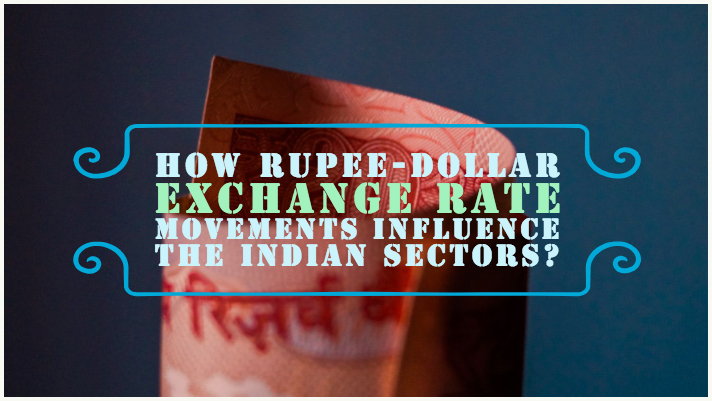The stock market is an integral part of the economy and doesn’t function in isolation. It is the barometer of a nation’s economic growth and reflects various key factors. Factors such as interest rates, GDP rates, trade policy, and currency movements. Out of these the strengthening and weakening of the Indian rupee have a major influence in the sectors of the economy. Data reveals that over the past decade, the Sensex/Nifty50 and the Rupee-Dollar exchange rate movement have shown a strong correlation. That too a positive one. This is also the case with various sectoral indices at both NSE and BSE.
In fact, lots of academic studies had quantified the exact correlation between them. One such estimate shows that there is a correlation of 0.44 between the Sensex and the Rupee-Dollar exchange rate movement. This means that 44% of the ups and downs in Sensex have been in tandem with the movements of the Indian Rupees.
What factors affect Indian rupee?
Some of the factors that impact the Indian stock market are the same as those that impact the Indian currency. These are the overall global economy and geopolitical developments. Along with it, trade deficit/surplus, monetary policies, forex reserves, foreign institutional investments etc also influence it.
Out of all these factors, the most important one is the FII flows. FII stands for foreign institutional investors. When there is an increase in investment by the FIIs in the market, the stock market automatically rises. This is turn helps overall sentiments to become buoyant. As a result, the outlook for Indian rupee becomes positive. As a natural outcome of this, the demand for the currency increases. This, in turn, enhances the strength of the Rupee-Dollar exchange rate.
Meaning of strong rupee and a weak rupee
First, let us understand the meaning of a strong and a weak rupee. A strong rupee refers to a situation when the rate of the rupee rises against other global currencies, especially the US Dollar. Some other names for a strong rupee are appreciated rupee or rupee appreciation and an overvalued currency.
This means a buyer has to spend less of a Rupee to buy a US Dollar. Let us understand this with the help of an illustration. Currently, the exchange rate of USDINR reference rate is 71.26. Now suppose if the rate stands at 70, we can say that the Indian rupee has strengthened. A buyer will have to spend lesser to buy a US dollar.
Advantages of a strong Rupee-Dollar exchange rate
When the rupee gains strength more investors are willing to park their money in the rupee-denominated assets. That is why we can see a lot of Foreign Institutional Investments (FIIs) when the rupee is stronger. Another implication of a strong rupee is that imports become cheaper.
When rupee gains strength, the importers will have to shell out lesser dollars to buy the particular commodity. Furthermore, India can also acquire more overseas assets. Plus, chances for acquiring Dollar-denominated assets become high with the strengthening of the rupee.
Now after assaying broadly the influence of strong rupee on the economy as a whole, let us move on to sectors.
Do Indian sectors benefit out of strong Rupee-Dollar exchange rate?
Definitely yes. Indian sectors do benefit from strengthening of rupee against the US dollar. However, not all the sectors-shows the positive impact of such rupee-dollar exchange rate strengthening. The sectors which benefit more mainly are the electronic and Oil sector. India imports about 65% of the electronic goods, while crude oil imports stand at 80%. The sectors that benefit out of a strong rupee against US Dollar are aviation, oil and gas marketing, metal and mining and paint makers among others. Let us discuss in brief about each of these sectors.
1. Indian aviation sector
The aviation sector across the world is hugely dependant on fuel prices. And India is no exception. Essentially almost 60-70% of the expenses on fuel are Dollar-denominated. So there is a huge impact of the forex rates on the Indian aviation sector.
If the rupee appreciates and becomes stronger, it is favourable for the aviation sector companies in India. But how? The answer to this is straight forward and is very crucial to long term Indian investors. Strong rupee shields aviation companies against forex loss and reduces their costs. And both of this has a significant impact on their profitability.
Thus, we see that there is a positive impact of strong Rupee-Dollar exchange rate on the Indian aviation sector. So, next time when you sense the strengthening of the Indian rupee against dollar, keep track on Interglobal Aviation, Spice Jet, Jet Airways, AlCargo, TCI Express, and others.
2. Oil & gas marketing companies of India
For oil & gas marketing companies in India the key material that they purchase, is crude oil. Since the majority of crude in India is met through imports so it is denominated in dollars. Hence, when the rupee is stronger, it helps them minimize their foreign exchange loss.
On the other hand, the oil & gas explorers in India may be hit by a strong rupee because their sales are dollar-denominated. Such companies will receive less rupee per dollar of exporting oil & gas and their by-products.
So, you need to keep track of companies from the oil and gas sector to see the consequence of rupee appreciation. You may require to trace ONGC, Oil India, HPCL, BPCL, Reliance, Selan Exploration, Aban Offshore, GAIL, IOC, IGL and the others.
3. Indian metal & mining sector
The companies from the metal and mining sectors in India likewise stand to gain from the strength in the rupee. This is so because most of their input costs are dollar denomination. Strengthening rupee eases input costs and favourably impact the gross margins of the company.
Due to a high establishing cost associated with this sector, the companies further have huge dollar debts. Therefore the companies from the metals and mining sector get a respite when the rupee gains strength against the US dollar.
Consequently, Tata Steel, Tata Metaliks, Orissa Minerals, Kalyani Steel, Precision Wires, Indian Metals, Tata Sponge are shares of companies worth watching. This will not only help determine the impact of rupee strengthening on Indian metal and mining sector but also help pick some good stocks for your long term portfolio.
4. Paint makers in India
The companies which are in the business of paint making in India holds direct impact in case of the rupee appreciating against the US dollar. For these companies, crude and titanium, its derivative, comprise 50%-60% of the raw material costs. Hence, when the rupee appreciates, they tend to save money on input costs. This in turn aid boosts their profitability.
Asian Paints, Berger Paints, Kansai Nerolac, Akzo Nobel, Sirca Paints, and Shalimar Paints are prominent paint makers in India. Keep watch in the paint sector when rupee tends to appreciate. They may add value to your long term investment portfolio.
Disadvantages of a weak Rupee-Dollar exchange rate
There are certain disadvantages associated with weak rupee as well. Most of the inputs in the manufacturing sector such as oil and steel are imported. As a result of the weak rupee, their import costs rise. In turn, manufacturers’ input costs rise. Thus, making their finished product costlier.
For companies from the textile, automobile, capital goods sector, the products cease to be more competitive in the export market. This hurts the nation’s economy as well. Now let us understand in some details about what actually week rupee means?
What is a weak Rupee-Dollar exchange rate?
What is a weak rupee? In simple words, a weak rupee situation a buyer will have to spend more of the domestic currency to buy the other currency, especially the US dollar. For example, if the USD-INR rate today rises from 71.26 to 72, it means that more rupee needs to be spent on buying the US dollar. Some of the other names of a weak currency are depreciated currency or undervalued currency.
When the rupee is weak, very few investors will be interested in putting money into rupee-denominated assets. The direct implication of a weak rupee is on the cross border trades. In general, export becomes cheaper while imports become stronger.
Advantages of weak Rupee-Dollar exchange rate
Week Rupee-Dollar exchange rate does have some benefit on any economies of the world. History bears testimony to the fact that the development of a country is directly related to a weak currency. In the 1960s, 1970s, and 1980s, Japan, Korea, and China, respectively, flourished on the back of their weak currencies.
One positive thing about India is that she has plenty of labour force and resources. Further, if used optimally can produce a lot of goods at low prices. Moreover, to boost our economy, we need to focus more on exporting goods and services at a competitive rate. This can only be possible if we have a weak rupee.
Thus, if a manufacturer wants to take advantage of week rupee then, it must be capable of exporting its product and services.
However, we must not forget one crucial thing about the week currencies. Whenever, the rupee experiences a free fall, both the corporate and stock investors come under immense pressure. This is so because a weak rupee increases uncertainty in the stock markets.
Notwithstanding, there are certain sectors which benefit out of the falling rupee. Especially the export-oriented sectors. The sectors that benefit out of a week rupee include the following –
1. Healthcare sector
India is among one of the popular destinations for health tourism. Moreover, this is one of the reasons why the healthcare services sector is deriving most of its revenues from international clients. So it stands to gain in the event of a weak rupee.
Additionally, the companies operating in the biologics, bioinformatics and clinical research segment will have huge opportunities in this regard.
Keep track on Fortis Healthcare, Apollo, SPARC, and Thyrocare.
2. IT/ ITES sector
The largest beneficiaries of a weak rupee are the IT/ITES sector. IT stands for information technology sector of India. While ITES stands for information technology-enabled service sector of India.
About 95% of the revenues of the IT/ITES companies generate their revenue from the US, Europe, and other nations. A depreciated rupee would mean that there is scope for more of US dollar revenue growth.
Whether the company is tier I and tier II, every company has great exposure to the overseas market and stands to gain out of a weak Rupee.
Look for Infy, Nucleus Soft, Persistent, TCS, eClerks, Tech Mahindra, Wipro, MphasiS, and etc.
3. Pharmaceutical sectors
Most of the Indian pharmaceutical sector companies gain revenue out of exports to the US Generic markets, which is to the extent of about 40%. When the currency depreciates, all the companies operating in the pharmaceutical sector gain due to favourable currency movements.
The benefits in sales and profitability arising out of a weak rupee outweigh the increase in the input cost of Active Pharmaceutical Ingredients (API). Pfizer, Glaxo Smith Kline, Sanofi India, Dr Reddys, Cipla, and Lupin must interest you in this sector.
4. Automobile sectors
The auto and ancillary industries which derive about 60% of their revenues from overseas exports. These companies will gain due to improvement in its margin and realization. However, in the domestic market, the rise in fuel cost due to weak rupee impacts the demand for automobiles. Thus, you just need to keep track of Maruti, HeroMotoCop, Tata Motors, Bosch, Minda Industries, Automotive Axle, Rane holdings, and etc.
Why is the knowledge of the Rupee-Dollar exchange rate is important for stock market investors?
While investing in stock markets, the investors must be aware of various factors that impact the market or the stocks in particular. The fluctuations in the Rupee to Dollar exchange rates is one such factor. Each sector responds differently to the changes in the USD-INR reference rate and if you know about the possible impacts of the changes then you can choose the sectors and stocks wisely.
When the Dollar to Rupee exchange rate appreciates then it is wise to select stocks that depend more on imports. These are stocks of companies which resell imported products or have most of the raw materials imported. The companies which have the high quantum of Dollar debt also are impacted by the fluctuations in the exchange rates.
When the Rupee weakens, it is best to choose stocks which are more export-oriented. When the currency is under pressure, the stocks of the companies involved in the IT/ITES, Pharmaceutical, Automobile sector or the Healthcare services are most preferable.
You need to reap maximum benefits out of the change in the forex rates. So it is best to adopt the sector rotation strategy. Thus, you will need to understand which sector to choose when the reference rate for the currency rises or falls. You may be holding more stocks from export-oriented sectors. But there may be a situation of rising rupee for a prolonged period. In such a situation, it is advisable to switch from these sectors. Furthermore, invest in sectors that are more conducive to the strengthening rupee.
About Author

Stock Trading Now trade in ₹9 Per Order or ₹ 999 Per Month Plans.
Future & Options Access F&O contracts with advanced tools for hedging and speculation.
Currency Trading Trade in major currency pairs and manage forex exposure efficiently.
Commodity Trading Diversify Trading with MCX & NCDEX by Trading in Gold, Silver, Base Metals, Energy, and Agri Products.
Margin Trading Funding Boost your buying power with upto 5X, Buy now Pay Later
Algo Trading Back test, Paper Trade your logic & Automate your strategies with low-latency APIs.
Trading View Leverage Trading View charts and indicators integrated into your trading platform.
Advanced Options Trading Execute multi-leg option strategies with precision and insights.
Stock Lending & Borrowing Earn passive income by lending stocks securely through SLB.
Foreign Portfolio Investment Enable NRIs and FPIs to invest in Indian markets with ease and compliance.
IPO Invest in upcoming IPOs online with real-time tracking and instant allotment updates.
Direct Mutual Funds 0% Commissions by investing in more than +3500 Direct Mutual Fund Scheme.
Corporate FDRs Earn fixed returns with low-risk investments in high-rated corporate fixed deposits.
Stocks SIPs Build long-term wealth with systematic investment plans in top-performing stocks.
Bonds & NCDs Access secure, fixed-income investments through government and corporate bond offerings.
Depository Services Safely hold and manage your securities with seamless Demat and DP services with CDSL.
Journey Tracing our growth and milestones over time.
Mission & Vision Guided by purpose, driven by long-term vision.
Why RMoney Platform Smart, reliable platform for all investors' needs.
Management Experienced leadership driving strategic financial excellence.
Credentials Certified expertise with trusted industry recognition.
Press Release Latest company news, updates, and announcements.
Testimonials Real client stories sharing their success journeys.
7 Reasons to Invest Top benefits that make investing with us smart.
SEBI Registered Research Trusted insights backed by SEBI-compliant research.
Our Technology Advanced tools enabling efficient online trading.
Calculators Access a suite of smart tools to plan trades, margins, and returns effectively.
Margin Calculator Instantly check margin requirements for intraday and delivery trades.
MTF Calculator Calculate MTF funding cost upfront to ensure full transparency before placing a trade.
Brokerage Calculator Know your exact brokerage charges before placing any trade.
Market Place Explore curated investment products and trading tools in one convenient hub.
RMoney Gyan Enhance your market knowledge with expert blogs, videos, and tutorials.
Performance Tracker Track our research performance with full transparency using our performance tracker.
Feedback Share your suggestions or concerns to help us improve your experience.
Downloads Access important forms, software, and documents in one place.
Locate Us Find the nearest RMoney branch or service center quickly.
Escalation Matrix Resolve issues faster with our structured support escalation process.
Back Office Log in to view trade reports, ledger, and portfolio statements anytime.
Account Modification Update personal or bank details linked to your trading account.
Fund Transfer Transfer funds instantly online with quick limit updation to your trading account.
Bank Details View our registered bank account details for seamless transactions by NEFT, RTGS or IMPS.
How to Apply IPO Step-by-step guide to apply for IPOs using your trading account.
RMoney Quick Mobile App Trade on-the-go with our all-in-one mobile trading app.
RMoney Quick login Quickly access your trading account through the RMoney Quick web-based trading.
RMoney Rocket Web Version Experience powerful web-based trading with advanced tools for algo traders.
RMoney Rocket Mobile Version Trade anytime, anywhere with our feature-rich mobile trading platform.




















